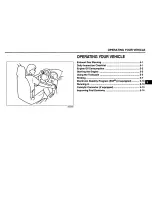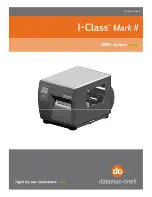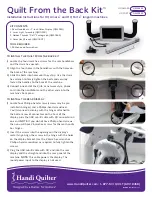
Connecting the tow bar
continued from page two
the holes in the outermost arm with the holes in one of the tabs on the
quick-disconnect base.
Attach the tow bar arm to the quick-disconnect base with one of the
included base pins. Attach the arm so that the head of the shoulder bolt
on the collar is facing up. Lock the base pin with a linch pin or optional
padlock.
The linch pin must be locked. The ring on the linch pin is spring-loaded
— it must be snapped over the pin, with the curved side of the linch pin
touching the ring, in order to keep the base pin secure.
Both tow bar arms must be attached to the quick-disconnect bases
and locked with a linch pin. Towing vibrations will force the linch pins
out unless they are properly locked in place over the base pins on
both quick-disconnect bases.
Failure to properly install and lock both base pins will result in the
loss of the towed vehicle, which may cause property damage, personal
injury or even death.
6.
Now, swing the other arm to the opposite side and connect it in the
same manner.
7.
Attach the safety cables and plug in the electrical wiring cord, according
to the supplier’s instructions.
Before towing the vehicle, be sure the steering is unlocked, the trans-
mission is in the proper setting, and the emergency brake is released.
Remove the wheel chock.
Check the manufacturer’s specifications or the owner’s manual for the
proper towing procedures or requirement(s) for the vehicle to be towed.
Do not tow the vehicle until the tow bar is attached with all pins or
padlocks. Unless the tow bar is secured to both vehicles with all ap-
propriate pins or padlocks, the vehicle will detach, which may cause
property damage, personal injury or even death.
When you drive away, steer briefly to the left and then to the right, to
extend, self-center and lock the tow bar.
Always stop at this time. Check the tow bar to ensure that both arms are
locked, before assuming highway speed. Additionally, check the other com-
ponents of your towing system, to ensure that they are fully engaged.
Both tow bar arms must be locked before towing. If they are not,
the momentum of the towed vehicle will apply excessive force to the
tow bar arms and other components of the towing system, which
may cause the towing system to fail, resulting in property damage,
personal injury or even death.
Do not tow a vehicle using tow bar mounting brackets, safety cables,
or a hitch receiver rated less than the actual weight of the towed
vehicle.
If the brackets, safety cables, hitch receiver or any supplementary
towing equipment is not rated at the weight of the towed vehicle and
all its contents, it may fail during towing, causing property damage,
personal injury or even death.
If the motorhome hitch receiver has an extension, do not tow if the
tow bar is more than three inches out of level.
Receiver extensions cause the towing system to swing much higher
and lower than towing systems without extensions. This enlarged
arc of motion creates excessive strain on the tow bar, brackets and
frame, which can cause the towing system to fail, resulting in property
damage, personal injury or even death.
Disconnecting the tow bar
1.
Disconnecting the tow bar is essentially the reverse of connecting it.
First, always try to park on level ground, with the towed vehicle in line
with the motorhome. This will eliminate most of the tension between the
vehicles, allowing for an easier disconnect.
2.
Disconnect the electrical wiring harness, safety cables, and any other
towing system accessories.
3.
Lift the release handles on each tow bar arm to release the locking
mechanisms.
(Usually, one of the handles will require more pressure to release. This is
the arm that has the majority of the tension between the two vehicles.)
Always put the towed vehicle in gear (park), set the emergency
brake and chock one of the wheels after lifting the release handles,
and before removing the base pins. Failure to do so may result in a
‘runaway’ vehicle or may crush you between the towed vehicle and
the motorhome, causing property damage, personal injury or even
death.
4.
Put the towed vehicle in gear (park), set the emergency brake, and
chock one of the wheels.
5.
Remove the base pins and store the tow bar on the motorhome by
reversing the connection procedure (under “Connecting the tow bar”).
ROADMASTER recommends replacing at least one of the linch pins with
a padlock (part number 301, 302 or 308) to prevent accidental release or
theft.
The tow bar can be stored on the motorhome with the arms rotated
to the left or the right. To avoid the possibility of damage to the
bushings, rotate the arms away from the engine exhaust.
The bushings at the end of the tow bar arms can be warped by heat
from the exhaust. If the bushings are warped, the tow bar arms will
not slide easily, or they may not slide at all — it may be difficult to
connect or disconnect the tow bar until the bushings are replaced.
Safety cables are an integral part of your towing system. They are a
secondary safety device, required by law in many states. This section,
and the section titled “Proper installation of safety cables,” will acquaint
you with how to use them properly.
•
Choose safety cables based on the weight of the towed vehicle.
The
weight capacity of the safety cables must meet or exceed the towed
weight, or the safety cables will fail.
Refer to the “Installer’s safety
checklist,” on page two, for further information.
•
The safety cables must connect the towing vehicle to the towed vehicle,
frame to frame.
•
Pull the safety cables so that all the slack is at the motorhome.
Make
sure there is enough slack in the cables at the motorhome to allow
for sharp turns
— if there is not enough slack, the towing system will
be severely damaged when the motorhome turns a sharp corner.
•
The safety cables must be the correct length…
•
Make sure the cables are not too short — if you use a receiver hitch
extension or other equipment that extends the distance between the
towed vehicle and the motorhome, the standard cables may be too
short. If the cables are too short, the towing system will be severely
damaged when the motorhome turns a sharp corner.
(Safety cable extensions in a wide variety of lengths are available from
ROADMASTER.)
•
Make sure the cables are not too long — the cables should not hang
down to the extent they may catch on obstructions, or drag on the
ground. This much slack could cause damage to the towing system,
the towed vehicle or the motorhome.
If the cables are too long, wrap the excess cable around the tow bar
continued on page four
3
The BlackHawk 2 owner’s manual…
…contains additional illustrations to accompany these instructions, as
well as important safety information, the limited warranty and other infor-
mation to make your towing experience safe and pleasant.
Read the owner’s manual cover to cover before towing a vehicle.
How to use safety cables






















